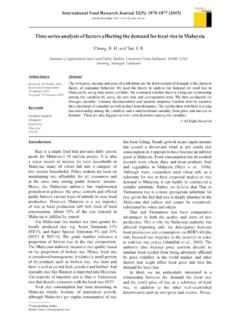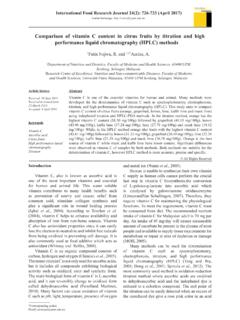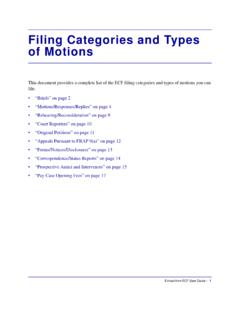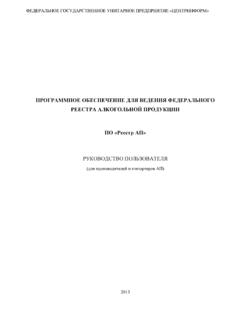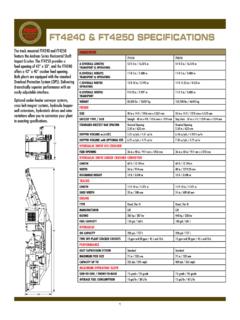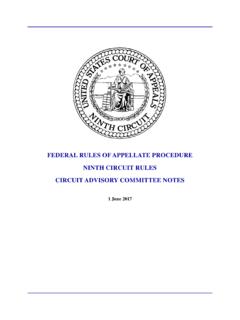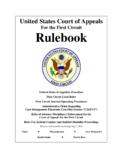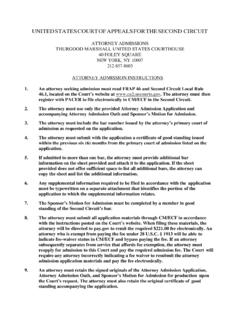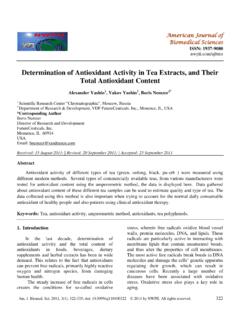Transcription of Antioxidant properties of peels extracts from three ...
1 International Food Research Journal 25(1): 57 - 64 (February 2018). Journal homepage: Antioxidant properties of peels extracts from three varieties of banana (Musa sp.) grown in West Java-Indonesia *. Fidrianny, I., Anggraeni, and Insanu, M. Pharmaceutical Biology Research Group, School of Pharmacy, Bandung Institute of Technology, Indonesia Article history Abstract Received: 26 October 2016 The aims of this research were to determine Antioxidant activity from different polarity peel Received in revised form: extracts of three varieties of banana using two methods of Antioxidant testing which were DPPH. 8 December 2016. Accepted:9 December 2016. (2,2-diphenyl-1-picrylhydrazyl) and CUPRAC (Cupric Reducing Antioxidant Capacity) and correlation of total phenolic, flavonoid and carotenoid content in different polarity extracts of banana peels with their IC50 of DPPH and IC50 of CUPRAC Antioxidant activities.
2 Extraction was conducted by reflux using different polarity solvents. The extracts were evaporated using rotary evaporator. Antioxidant activities, determination of total phenolic, flavonoid Keywords and carotenoid content were performed by UV-visible spectrophotometry and its correlation Antioxidant , DPPH, with IC50 of DPPH scavenging activities and EC50 of CUPRAC capacities were analyzed by CUPRAC, Pearson's method. All of peel extracts banana and nangka banana (except ethanolic peel extract three varieties of banana, of nangka banana) were categorized as very strong Antioxidant , using DPPH assay. Phenolic peels compounds in tanduk banana and nangka banana peel extracts were the major contributor in their Antioxidant activities by DPPH and CUPRAC assays. Peel extracts of nangka banana gave linear results in DPPH and CUPRAC assays. All Rights Reserved Introduction (2011) and Darsini et al.
3 (2012) stated that banana had Antioxidant activities by using DPPH, ABTS and Phenolic compounds are commonly found FRAP assays. in plants, and they have been reported to have The goals of this research were to determine multiple biological effects, included antibacterial Antioxidant activities of various polarity peel extracts and Antioxidant activity (Mokbel and Hashinaga, (n-hexane, ethyl acetate and ethanol) of three varieties 2005; Fawole et al. 2012). Previous study (Souri et of banana (Musa sp.) which grown in West Java- al., 2008; Xu and Chang, 2008; Zielinski et al., 2014 Indonesia using DPPH and CUPRAC assays, and Butsat and Siriamornpun, 2016) figured that phenolic correlations between total phenolic, flavonoid and and flavonoid content could be correlated to their carotenoid content with their Antioxidant activities. Antioxidant activities. Consumption of Antioxidant can prevent oxidative stress which can cause many Materials and Methods diseases.
4 Plants include guava, tea, coffee, banana, papaya contain phenolic and flavonoid compounds Materials (Castillo et al., 2002; Thaipong et al., 2006; DPPH (2,2-diphenyl-1-picrylhydrazyl) , Chan et al., 2007; Darsini et al., 2012; Maisarah neocuproine, gallic acid, quercetin, beta carotene et al., 2013). Peel of banana contain naringin were purchased from Sigma-Aldrich (MO, USA), (flavanone glycoside) and rutin (flavonol glycoside) cupric chloride, banana peels . All other reagents were (Kanazawa and Sakakibara, 2000) and lutein, beta- analytical grades. carotene, alpha-carotene, violaxanthin, auroxanthin, neoxanthin, isolutein, beta-cryptoxanthin and alpha- Preparation of sample cryptoxanthin (Subagio et al., 1996). peels of three varieties of banana (Musa sp.). Previous researches (Thaipong et al., 2006; which were: tanduk banana namely as TAN collected Apak et al., 2007; Fidrianny et al.)
5 , 2013) expressed from Bandung- West Java, nangka banana as NAN. that DPPH, CUPRAC, FRAP and ABTS methods and kepok banana as KEP from Cimahi-West Java, could be used to determine Antioxidant activity in were thoroughly washed with tap water, sorted while many plants extracts . Studies by Sulaiman et al. wet, cut, dried and grinded into powder. *Corresponding author. 58 Fidrianny, I., Anggraeni, and Insanu, 25(1) : 57 - 64. Extraction Total flavonoid content (TFC). three hundred gram of powdered sample was Determination of total flavonoid content was extracted by reflux using various polarity solvents. conducted using method from Chang et al. (2002). Extraction using n-hexane was repeated three times. The absorbance was read at wavelength 415 nm. The remaining residue was then extracted three times Analysis was done in triplicate for each extract. by using ethyl acetate.
6 Finally the remaining residue Quercetin standard solution (36-100 g/ml) was was extracted three times using ethanol. Therefore used to obtain a calibration curve. The total flavonoid totally nine extracts there were: three n-hexane content was exposed as percentage of total quercetin extracts (namely TAN1, NAN1 and KEP1), three equivalent per 100 g extract (g QE/100 g). ethyl acetate extracts (TAN2, NAN2 and KEP2) and three ethanolic extracts (TAN3, NAN3 and KEP3). Total phenolic content (TPC). Total phenolic content evaluation was performed Inhibitory Concentration 50 (IC50) of DPPH using Folin-Ciolcalteu reagent (Pourmorad et al., scavenging activity 2006) with minor modification. The absorbance Preparation of DPPH solution was performed was measured at wavelength 765 nm. Analysis using Blois's method (Blois, 1958) with minor was done in triplicate for each extract.
7 Gallic acid modification. Various concentrations of each standard solution (105-200 g/ml) was used to extract were pipetted into DPPH solution 50 g/ml obtain a calibration curve. Total phenolic content was (volume 1:1) to initiate the reaction for obtaining a presented as percentage of total gallic acid equivalent calibration curve. The absorbance was read after 30 per 100 g extract (g GAE /100 g). minutes incubation at wavelength 515 nm by using UV-Vis spectrophotometer Beckman Coulter DU Total carotenoid content (TCC). 720. Methanol was used as a blank, DPPH solution Determination of total carotenoid content was 50 g/ml as control and ascorbic acid as standard. measured using modified method which was adapted Analysis was carried out in triplicate for standard from Thaipong et al. (2006). Each extract was diluted and each extract. Antioxidant activity of each extract in n-hexane (Fidrianny et al.)
8 , 2013). The absorbance by DPPH method was determined by calculating was read at wavelength 470 nm. Analysis was percentage of Antioxidant activity using reduction of conducted in triplicate for each extract. Beta carotene DPPH absorbance (Bedawey, 2010). IC50 of DPPH standard solution (30-100 g/ml) was used to obtain scavenging activity of each extract can be calculated a calibration curve. The total carotenoid content using its calibration curve. was reported as percentage of total beta carotene equivalent per 100 g extract (g BE/100 g). Exhibitory concentration 50 (IC50) of CUPRAC. capacity Statistical analysis Preparation of CUPRAC solution was adopted Each sample analysis was performed in triplicate. from Apak's method (Apak et al., 2007). The All results presented are means ( standard deviation). CUPRAC solution was prepared in ammonium of at least three independent experiments.
9 Statistical acetate buffer pH 7. Each extract were prepared in analysis using ANOVA with a statistical significance various concentrations and pipetted into CUPRAC level set at p < and post-hoc Tukey procedure 50 g/ml (1:1) to initiate the reaction for obtaining was carried out with SPSS 16 for Windows. a calibration curve. After 30 minutes incubation, the Correlation between the total phenolic, flavonoid, absorbance was read at wavelength 450 nm by using carotenoid content and Antioxidant activities, and UV-Vis spectrophotometer Beckman Coulter DU correlation between two Antioxidant activity methods 720. Ammonium acetate buffer was used as a blank, were performed using the Pearson's method. CUPRAC solution 50 g/ml as control and ascorbic acid as standard. Analysis was done in triplicate for Results and Discussion standard and each extract. Antioxidant capacity of each extract was evaluated based on increasing in Cu Banana had Antioxidant activity which was (I)-neocuproine absorbance by calculating percentage revealed in previous studies by Sulaiman et al.
10 Of Antioxidant capacity (Apak et al., 2007). EC50 of (2011) and Darsini et al. (2012). There was no CUPRAC capacity of each extract can be calculated research regarding Antioxidant activity of various using its calibration curve. polarity extracts (which were n-hexane, ethyl acetate and ethanol) from peel of three varieties of bananas grown in West Java- Indonesia using DPPH and CUPRAC assays. Fidrianny, I., Anggraeni, and Insanu, 25(1) : 57 - 64 59. IC50 of DPPH scavenging activity and EC50 of Reagent of CUPRAC is CuCl2 which is combined CUPRAC capacity with neocuproine in ammonium acetate buffer The IC50 of DPPH scavenging activities and pH 7. Cu (II) will be reduced to Cu (I). Complex EC50 of CUPRAC capacities in various extracts Cu (I) neocuproine gives yellow color and show of banana peels using DPPH and CUPRAC assays characteristic absorption at wavelength 450 nm (Apak were shown in Figure 1 and Figure 2.)



